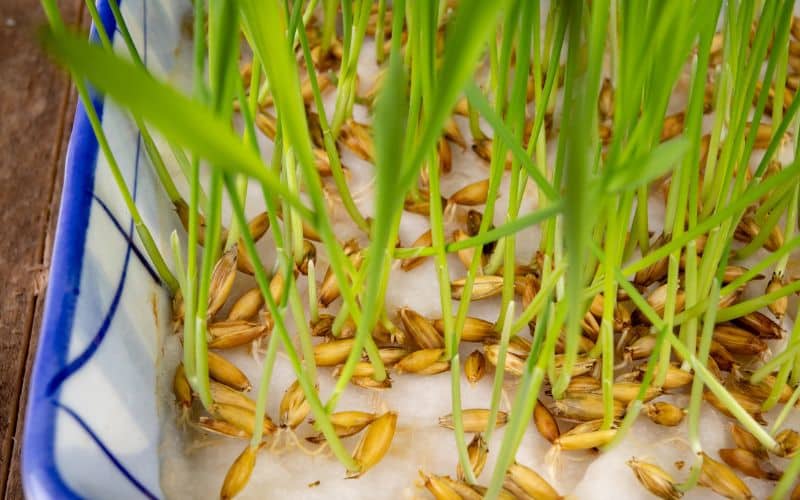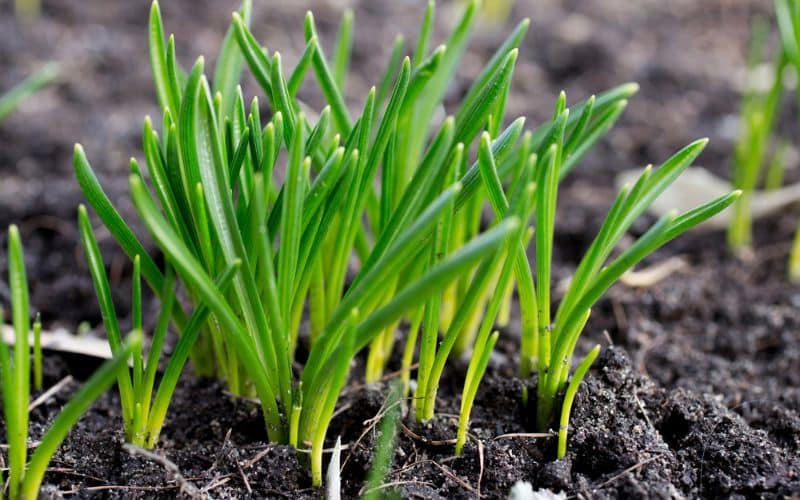
Ever wondered why your grass isn’t sprouting as you’d hoped? Temperature could be the culprit. Different grass seeds have their own sweet spot for germination, and getting it right can mean the difference between a patchy lawn and the lush green carpet you’re aiming for.
Whether you’re working with cool-season varieties like Kentucky bluegrass or warm-season favourites like Bermuda grass, understanding these temperature needs is key to a successful germination. Keep reading to learn how to achieve that perfect germination temperature for a lawn that’ll be the envy of the neighbourhood.
Understanding Germination
What is Germination?
Germination is the crucial process by which a grass seed sprouts and begins to grow into a new plant. During this phase, Enzymes become active, breaking down stored food within the seed. This reaction triggers the seed to expand, breaking its coat, and allows for the emergence of the root (radicle) and shoot (plumule), which will develop into the grass plant.
- Activation Stage: Water absorption kickstarts germination
- Respiration Increases: Oxygen uptake rises significantly
- Seedling Emergence: Root and shoot grow and emerge from the soil
Why is Germination Important for Grass Seed?
Germination is the foundation for developing a dense, vibrant lawn. Optimal germination ensures that seeds convert into healthy seedlings, setting the stage for a robust grass plant. When grass seeds germinate effectively:
- Dense Turf: Uniform germination leads to even coverage, reducing bare spots.
- Vigorous Growth: Healthy germination translates into stronger grass that can better compete with weeds and resist pests.
- Resource Utilization: Properly germinated seeds utilize water and nutrients more efficiently, leading to sustainable lawn health.
Factors Affecting Germination
Germinating grass seeds isn’t just about planting them and hoping for the best. You’ll need to consider several crucial factors that significantly influence germination rates and the overall success of your lawn. Addressing these factors effectively helps ensure vigorous and healthy grass growth.
Temperature
The temperature of the soil plays a pivotal role in the germination of grass seeds. Each grass type has a distinct optimal soil temperature range where germination rates are maximized:
- Cool-Season Grasses: Best between 50°F (10°C) to 65°F (18.3°C)
- Warm-Season Grasses: Prefer soil temperatures above 65°F (18.3°C)
Temperature consistency is just as important as the range. Fluctuations can delay or inhibit germination, making stable soil conditions during the seeding phase essential.
Moisture
Moisture is the lifeblood of seed germination. Without it, seeds fail to sprout:
- Seeds need steady moisture to activate the germination cycle.
- Adequate watering ensures seeds don’t dry out.
- Overwatering can cause seeds to rot.
Balanced moisture is key. The soil should feel moist to the touch but not waterlogged. A fine spray is the recommended method to maintain even moisture without displacing the seeds.
Light
While light isn’t as critical during the initial germination phase, it becomes essential once the grass seedlings emerge:
- Seedlings require sunlight—minimum of 6 hours daily—for robust growth.
- Light affects photosynthesis which is vital for the young plant’s development.
- Some seeds may need to be covered lightly by soil, depending on their specific light requirements.
Always check the seed’s packet instructions for any particular light conditions or cover necessary.
Soil pH
The acidity or alkalinity of the soil, denoted as pH, can affect grass seed germination:
- Most grass types thrive in a pH range of 6 to 7.5.
- A pH outside this range can inhibit nutrient absorption and affect growth.
- Testing your soil’s pH prior to planting is advisable to take corrective measures if needed.
By ensuring the pH is within the desired range, you optimize nutrient availability which is essential for germination and early seedling growth.
Soil Quality
Finally, the quality of the soil itself can have a profound impact on germination:
- Loose, well-aerated soil allows for better oxygen supply to the seeds.
- High-quality soils contain adequate nutrients to support new seedlings.
- The presence of weeds, rocks, or debris can impede growth and should be removed during site preparation.
You should consider enriching poor soils with organic matter or compost to improve soil structure and fertility, thus boosting the chances of successful germination.

Optimal Germination Temperatures
As you’re working towards a lush lawn, understanding the optimal germination temperatures for grass seeds is paramount. Different grass types have unique needs, so let’s delve into the temperatures that provide the best conditions for your seeds to thrive.
Cool-Season Grasses
For cool-season grasses like Kentucky Bluegrass and Perennial Ryegrass, you’re looking at a narrow window of soil temperatures that must be just right. 50°F (10°C) to 65°F (18.3°C) are the magic numbers that prompt these varieties to wake up and start sprouting.
Here’s a quick glance at the Optimal Germination Temperature for popular cool-season grass types:
| Grass Type | Optimal Germination Temperature (°F) |
|---|---|
| Perennial Ryegrass | 50 – 65 |
| Kentucky Bluegrass | 55 – 75 |
- Perennial Ryegrass is known for its ability to germinate rapidly, even at cooler temperatures like 35°F (1.7°C), although optimal growth is seen when the soil is warmer.
- Kentucky Bluegrass can surprise you by sprouting at temperatures as low as 32°F (0°C), yet ideal planting is recommended when soil reaches 50-60°F (10-15.6 °C).
To ensure these seeds have the best start, planting is best done in spring or fall. This is when soil temperatures align with their preferences, and the threat of intense heat or a sudden freeze is minimal.
Warm-Season Grasses
Moving on to warm-season grasses such as Bermuda grass, Zoysia, Bahia grass, and Centipede grass, they flourish in the heat where cool-season varieties would falter. Their perfect germination conditions kick in with soil temperatures consistently at or above 70°F (21°C).
Check out this vital Optimal Soil Temperature data:
| Grass Type | Optimal Soil Temperature (°F) | Optimal Soil Temperature (°C) |
|---|---|---|
| Bermuda grass | 65 – 70 | 18 – 21 |
| Zoysia | 70 + | 21 + |
| Bahia grass | 65 – 70 | 18 – 21 |
| Centipede grass | 65 – 70 | 18 – 21 |
- Bermuda grass thrives within 65°F (18°C) to 70°F (21°C), making it an ideal choice for hot climates.
- Zoysia is slightly more heat-loving, often needing soil temperatures above 70°F (21°C) to get going.
- Both Bahiagrass and Centipedegrass have similar requirements, ensuring robust growth in warm soils.
Timing is everything, and for these warm embracers, late spring through early summer planting allows them to firmly root themselves before the cool air sets in. With their high temperature germination threshold, these grasses capitalize on the long, warm days to establish a strong and vibrant lawn.

Germination Challenges
Germination is a delicate phase in a plant’s life cycle, and for grass seeds, this process can be hindered by various temperature-related issues. Below, you’ll gain insights into how these challenges can impact the success of your lawn and ways to address them.
Cold Soil Temperatures
Inadequate warmth can cause a standoff between you and the lush lawn you’re hoping for. Cold soil temperatures often result in Delayed Germination. Grass seeds, especially cool-season varieties which prefer soil temperatures of 50°F to 65°F (10°C to 18.3°C), will lay dormant when the soil dips below these thresholds. During UK winters, with soil temperatures dropping below 9°C, regular grass seed struggles to grow, leaving lawns patchy.
Seeds also face the risk of pre-germination Frost Damage if a drop in temperature follows planting. A frost can destroy newly sprouted seedlings, leading to wasted effort and the need for reseeding.
Hot Soil Temperatures
While warm-season grasses thrive at or above 70°F (21°C), overly hot soil temperatures can be just as problematic as cold ones. Excessive heat leads to Evaporation of Essential Moisture, making it challenging for seeds to access the water they need for germination. Seedlings may encounter Heat Stress, which weakens their development and increases the likelihood of failure to establish a healthy lawn.
Protecting your seeds with a light layer of mulch helps in Regulating Soil Temperature, thus retaining moisture. Providing temporary shade also assists in Reducing Heat exerted directly on the soil, creating a more congenial environment for your warm-season seeds to sprout.
Temperature Fluctuations
Rapid changes between hot and cold temperatures can have an adverse effect on grass seed germination. Fluctuating conditions confuse seeds about the right time to germinate, leading to a Disrupted Germination Cycle. Cool-season grasses struggle if exposed to high temperatures too early in their lifecycle, whereas warm-season grasses may go into a dormant state when faced with unexpected cold.
Stabilizing the Microclimate around your seeds can make a difference. Achieve this by using mulch to maintain consistent soil moisture and temperature or applying water at the cooler times of the day to minimize stress on the seeds.
Regular Monitor of Soil Temperature with a thermometer ensures you’re providing the best conditions for your grass seeds to germinate without the risk of dormancy due to temperature volatility. By being aware and responsive to these challenges, you’ll set your lawn on a path to optimal growth.
Conclusion
You’ve now got the knowledge to ensure your grass seeds thrive. Remember, timing is everything—sow your seeds when the soil is just right for your chosen grass type. With your soil well-prepared and your watering balanced, you’re setting the stage for a lush, green lawn. Don’t let the sun scorch your efforts; protective shade or mulch can be a game-changer. Put in the work now and you’ll reap the rewards of a beautiful lawn that’ll be the envy of the neighbourhood. Your lawn’s future health truly lies in the care you provide during these crucial early stages.
Colin Macmillan is a seasoned entrepreneur and the CEO of Riverwood Landscape, a leading landscaping company based in Canada. He has been at the helm of the company since leaving high school, demonstrating his strong leadership skills and business acumen.
Colin’s expertise lies in various aspects of landscaping, including lawn care, interlocking, sod installation, and commercial maintenance. His hands-on approach and dedication to the craft have been instrumental in building Riverwood Landscape into a reputable brand.
One of his most notable achievements is the creation of a successful landscape franchise that services multiple locations. This accomplishment underscores his strategic thinking and ability to scale operations effectively.
Colin has also had the privilege of working with Guelph Hospital for landscaping and maintenance, a testament to the trust and reliability that his company has earned over the years.
His professional mission is to offer the best services and experiences for customers, a goal that he tirelessly pursues. Colin’s commitment to excellence and customer satisfaction continues to drive the growth and success of Riverwood Landscape.








